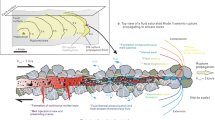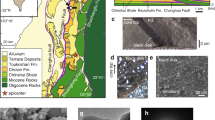Abstract
Earthquake instability has long been attributed to fault weakening during accelerated slip1, and a central question of earthquake physics is identifying the mechanisms that control this weakening2. Even with much experimental effort2,3,4,5,6,7,8,9,10,11,12, the weakening mechanisms have remained enigmatic. Here we present evidence for dynamic weakening of experimental faults that are sheared at velocities approaching earthquake slip rates. The experimental faults, which were made of room-dry, solid granite blocks, quickly wore to form a fine-grain rock powder known as gouge. At modest slip velocities of 10–60 mm s−1, this newly formed gouge organized itself into a thin deforming layer that reduced the fault’s strength by a factor of 2–3. After slip, the gouge rapidly ‘aged’ and the fault regained its strength in a matter of hours to days. Therefore, only newly formed gouge can weaken the experimental faults. Dynamic gouge formation is expected to be a common and effective mechanism of earthquake instability in the brittle crust as (1) gouge always forms during fault slip5,10,12,13,14,15,16,17,18,19,20; (2) fault-gouge behaves similarly to industrial powder lubricants21; (3) dynamic gouge formation explains various significant earthquake properties; and (4) gouge lubricant can form for a wide range of fault configurations, compositions and temperatures15.
This is a preview of subscription content, access via your institution
Access options
Subscribe to this journal
Receive 51 print issues and online access
$199.00 per year
only $3.90 per issue
Buy this article
- Purchase on Springer Link
- Instant access to full article PDF
Prices may be subject to local taxes which are calculated during checkout





Similar content being viewed by others
References
Jordan, T. (committee chair) Living on an Active Earth: Perspectives on Earthquake Science (National Research Council, 2003)
Dieterich, J. H. Modeling of rock friction. 1. Experimental results and constitutive equations. J. Geophys. Res. 84, 161–162,–168 (1979)
Dieterich, J. H. Constitutive properties of faults with simulated gouge. Geophys. Monogr. 24, 103–120 (1981)
Hirose, T. & Shimamoto, T. Slip-weakening distance of faults during frictional melting as inferred from experimental and natural pseudotachylytes. Bull. Seismol. Soc. Am. 95, 1666–1673 (2005)
Mizoguchi, K., Hirose, T., Shimamoto, T. & Fukuyama, E. Moisture-related weakening and strengthening of a fault activated at seismic slip rates. Geophys. Res. Lett. 33 L16319 10.1029/2006GL026980 (2006)
Ruina, A. Slip instability and state variable friction laws. J. Geophys. Res. 88, 19359–19370 (1983)
Di Toro, G., Goldsby, D. L. & Tullis, T. E. Friction falls towards zero in quartz rock as slip velocity approaches seismic rates. Nature 427, 436–439 (2004)
Beeler, N. M. & Tullis, T. E. Self-healing slip pulses in dynamic rupture models due to velocity dependent strength. Bull. Seismol. Soc. Am. 86, 1130–1148 (1996)
Marone, C. J. Laboratory-derived friction laws and their application to seismic faulting. Annu. Rev. Earth Planet. Sci. 26, 643–696 (1998)
Marone, C. J. Earthquake science—faults greased at high speed. Nature 427, 405–406 (2004)
Mair, K. & Marone, C. J. Friction of simulated fault gouge for a wide range of velocities and normal stresses. J. Geophys. Res. 104, 28899–28914 (1999)
Yund, R. A., Blanpied, M. L., Tullis, T. E. & Weeks, J. D. Amorphous material in high strain experimental fault gouges. J. Geophys. Res. 95, 15589–15602 (1990)
Scholz, C. H. The Mechanics of Earthquakes and Faulting 2nd edn (Cambridge Univ. Press, 2002)
Lockner, D. A. et al. Geometry of the Nojima Fault at Nojima-Hirabayashi, Japan. I. A simple damage structure inferred from borehole core permeability. Pure Appl. Geophys. 166, 1649–1667 (2009)
Ben-Zion, Y. & Sammis, C. G. Characterization of fault zones. Pure Appl. Geophys. 160, 677–715 (2003)
Wilson, B., Dewers, T., Reches, Z. & Brune, J. Particle size and energetics of gouge from earthquake rupture zones. Nature 434, 749–752 (2005)
Brodsky, E. E. & Kanamori, H. Elastohydrodynamic lubrication of faults. J. Geophys. Res. 106, 16,357–16,374 (2001)
Byerlee, J. D. Frictional characteristics of granite under high confining pressure. J. Geophys. Res. 72, 3639–3648 (1967)
Beeler, N. M. & Tullis, T. E. Implications of Coulomb plasticity for the velocity dependence of experimental faults. Pure Appl. Geophys. 144, 251–276 (1995)
Wang, W. B. & Scholz, C. H. Wear processes during frictional sliding of rock—a theoretical and experimental study. J. Geophys. Res. 99, 6789–6799 (1994)
Wornyoh, E. Y. A., Jasti, V. K. & Higgs, C. F. A review of dry particulate lubrication: powder and granular materials. J. Tribol. 129, 438–449 (2007)
Binggeli, M. & Mate, C. M. Influence of water-vapor on nanotribology studied by friction force microscopy. J. Vacuum Sci. Technol. B 13, 1312–1315 (1995)
Muhuri, S. K., Dewers, T. A., Scott, T. E. & Reches, Z. Interseismic fault strengthening and earthquake-slip instability: friction or cohesion? Geology 31, 881–884 (2003)
Rabinowicz, E. The relation between friction and wear for boundary-lubricated surfaces. Proc. Phys. Soc. Lond. B 68, 603–608 (1955)
Godet, M. The 3rd-body approach—a mechanical view of wear. Wear 100, 437–452 (1984)
Higgs, C. F., Heshmat, C. A. & Heshmat, H. S. Comparative evaluation of MoS2 and WS2 as powder lubricants in high speed, multi-pad journal bearings. J. Tribol. 121, 625–630 (1999)
Heshmat, H. The quasi-hydrodynamic mechanism of powder lubrication. 3. On theory and rheology of triboparticulates. J. Tribol. 38, 269–276 (1995)
Ide, S. & Takeo, M. Determination of constitutive relations of fault slip based on seismic wave analysis. J. Geophys. Res. 102, 27379–27391 (1997)
Paterson, M. S. & Wong, T. F. Experimental Rock Deformation—The Brittle Field 347 (Springer, 2005)
Hiratsuka, K. & Muramoto, K. Role of wear particles in severe–mild wear transition. Wear 259, 467–476 (2005)
Hird, J. R. & Field, J. E. A wear mechanism map for the diamond polishing process. Wear 258, 18–25 (2005)
Acknowledgements
We thank J. Young, who built our instrument, as well as E. Eshkol, M. Hamilton, D. Moore, A. Madden, J. Chang and S. Busetti. Comments and reviews by J. Andrews, N. Beeler, C. Sammis, T.-f. Wong and J. Fineberg improved the manuscript. This study is supported by the National Science Foundation, Geosciences, Equipment and Facilities (grant number 0732715).
Author information
Authors and Affiliations
Contributions
All authors made equal contributions to this study.
Corresponding authors
Ethics declarations
Competing interests
The authors declare no competing financial interests.
Supplementary information
Supplementary Information
This file contains Supplementary Information comprising Experimental set- up, Steady-state friction and Wear calculation. Also included are and Supplementary Figures 1-6 with legends and an additional reference. (PDF 724 kb)
Rights and permissions
About this article
Cite this article
Reches, Z., Lockner, D. Fault weakening and earthquake instability by powder lubrication. Nature 467, 452–455 (2010). https://doi.org/10.1038/nature09348
Received:
Accepted:
Issue Date:
DOI: https://doi.org/10.1038/nature09348
This article is cited by
-
Intermittent lab earthquakes in dynamically weakening fault gouge
Nature (2022)
-
Integrated rupture mechanics for slow slip events and earthquakes
Nature Communications (2022)
-
Laboratory friction-permeability response of rock fractures: a review and new insights
Geomechanics and Geophysics for Geo-Energy and Geo-Resources (2022)
-
Nanometric flow and earthquake instability
Nature Communications (2021)
-
Coseismic fault lubrication by viscous deformation
Nature Geoscience (2021)
Comments
By submitting a comment you agree to abide by our Terms and Community Guidelines. If you find something abusive or that does not comply with our terms or guidelines please flag it as inappropriate.



